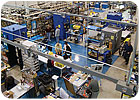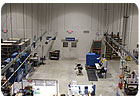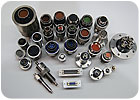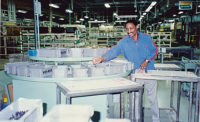
Since 1945, Douglas Electrical Components (DECO) has built a reputation for supplying premium products to a select market, including space agencies, the military and the semiconductor industry.
Recently, however, we faced a dilemma. On one hand, domestic engineering and sourcing was a big plus for many of our customers. On the other, price was still a significant basis for many of our customers’ purchasing decisions. We faced the challenge of maintaining, or even improving, our industry-leading quality and delivery times, while at the same time increasing our efficiency to keep our pricing aligned with that of our offshore-sourced competitors.
As pioneers in the application of epoxy to electrical wire feedthroughs, DECO works with customers to develop high-quality products for their conductor-sealing needs. DECO is an ISO 9001 registered manufacturer of UL-approved electrical and fiber-optic feedthroughs, hermetically sealed connectors and cables, explosion-proof wire assemblies, and turnkey subassemblies for semiconductor manufacturing equipment. Major applications include automotive, magnetic bearing, power generation and distribution, semiconductor processing, space simulation, military, alternative energy, air conditioning and refrigeration, X-ray equipment, and oil and gas exploration.
When we looked at the challenges we faced, we realized a lean initiative could provide the solution. But, we’re a job shop manufacturing a wide variety of custom-engineered products in volumes ranging from a few samples to a few hundred thousand. We do something different every day. We knew lean worked in large corporations, but we were not sure what the net would be for our type of business.
That’s when lean consultants PDG Inc. became involved. I sought bids from three groups to assist us with our lean transformation. PDG immediately stood out as a great match for our needs, mainly because they pledged to stay involved throughout the process, working directly on our shop floor.
“We…presented to Douglas in November of 2008,” recalls John Fischbach, the PDG lean consultant assigned to lead our initiative. “They gave us the go ahead within weeks, and we started the program [by early December], just a few months before the downturn really kicked in.”
In some ways, we could not have picked a worse time to spend money. On the other hand, when the recession hit, we had plenty of time and space to give to our lean program and kaizen events, and that really let us get the most out of the process. While it was a tough decision to make at the time, I am glad we moved forward and made the investment as planned.

DECO’s precision instruments cell concentrated on improving inventory and storage issues. The team also looked at ways to integrate features, such as test fixtures and packaging elements. For example, before lean, pressure and vacuum test fixtures were located outside the cell (above). Now, cell-specific fixtures are built in. DECO also relocated tasks and materials to reduce excess motion and walking within the cell (below).
Improvement Cell by Cell
Like all successful initiatives, the DECO lean project started with a plan. We began with a comprehensive value stream mapping process, performed in conjunction with lean team leaders and manufacturing floor personnel. Part of this process let us see where opportunities lay for the biggest gains. The observations helped lead us through our cell-by-cell kaizen events.
The value stream process revealed several opportunities to increase efficiency by becoming more organized, improving standards, reducing excess motion in the cells, improving ergonomics and safety, creating common processes, and reducing the number of “touches” required to assemble a product.
These activities resulted in a 12 to 18 month plan for continuous process improvement based on developing a deep understanding of performance trends, errors and defects. Some specific action items included:
• improving overall inventory replenishment.
• creating an easier vacuum test fixture.
• getting clips for hi-pot testing, so there is no need to strip wires.
• cross-training to achieve efficient work times.
• removing unnecessary equipment.
• getting a pneumatic cable cutter.
There were many other action plan items. Each team was encouraged to suggest any changes they thought valid. No part of any process was off limits. The teams were continuously challenged to take a fresh look at each part of their workflow, with the goal of developing tools that could apply to any project that came through the door.
The value stream process revealed several opportunities to increase efficiency by becoming more organized, improving standards, reducing excess motion in the cells, improving ergonomics and safety, creating common processes, and reducing the number of “touches” required to assemble a product.
These activities resulted in a 12 to 18 month plan for continuous process improvement based on developing a deep understanding of performance trends, errors and defects. Some specific action items included:
• improving overall inventory replenishment.
• creating an easier vacuum test fixture.
• getting clips for hi-pot testing, so there is no need to strip wires.
• cross-training to achieve efficient work times.
• removing unnecessary equipment.
• getting a pneumatic cable cutter.
There were many other action plan items. Each team was encouraged to suggest any changes they thought valid. No part of any process was off limits. The teams were continuously challenged to take a fresh look at each part of their workflow, with the goal of developing tools that could apply to any project that came through the door.

In With the New
In each cell, dramatic improvements and sometimes unanticipated benefits were realized. For example, in the switchgear cell, we tackled the challenges of inventory management, operator motion, rehandling, batching and standard work. As a result of our improvements, the cell improved lead times and productivity by more than 50 percent, and the number of product touches were reduced by over half.Before lean changes, poly-curing in the cell took three hours in a separate oven. Now, poly-curing takes two hours in the same oven. There had also been ineffective use of a table top with a vacuum pump. Pump and table use became more efficient by rewiring the pump and placing it under the table with a switch on top. Unnecessary motion and walking during cable cutting and stripping was minimized by combining multiple processes in one location.
“For this lean team, it was a real lesson in discovering the efficiency of one-piece flow,” says PDG’s Fischbach. “Line balancing really does make the job much easier.”
Our precision instruments cell makes products for the semiconductor manufacturing market. This cell concentrated on improving batching and corresponding inventory and storage issues. The team also looked at ways to integrate features such as test fixtures and packaging elements.
For example, before lean, pressure and vacuum test fixtures were located outside the cell. Now, cell-specific fixtures are built in. We also relocated tasks and materials to reduce excess motion and walking within the cell. Instead of putting epoxy for potting into an oven for preheating, as we did previously, we now put it in a warmer set at a fixed temperature, eliminating approximately 0.5 second per syringe.
As a result of these efforts, the cell improved lead times and production efficiency by more than 40 percent.
“This was a real tribute to working with the operators. Ideas straight from the floor were the real key to the successes we saw,” says Fischbach.

Custom hermetic feedthroughs come in all shapes in sizes.
High Quality, Competitive Pricing
The dramatic improvements in our workcells certainly prove the value of lean, but what did it bring to our business? For DECO, the efficiency gains translated directly into cost control and competitive positioning.I would have to say that we achieved all we set out to do, and more. Our lead times, product quality and pricing are now aligned to maintain our industry leadership position, as well as helping us to remain competitive in the face of increased overseas competition. The ability to offer the advantages of local engineering, production and fast lead times, all at a competitive price is even more important in the new economy. Our current success is directly linked to the investment we made in our people and processes.
ASSEMBLY ONLINE
For more information on lean manufacturing, visit www.assemblymag.com for these articles and podcasts:•Podcast: Designing Manufacturing Equipment for Lean.
•White Paper: Lista Relies on its Own Products for Lean Initiative.
•Leading Lean: Make Everything Visual.
